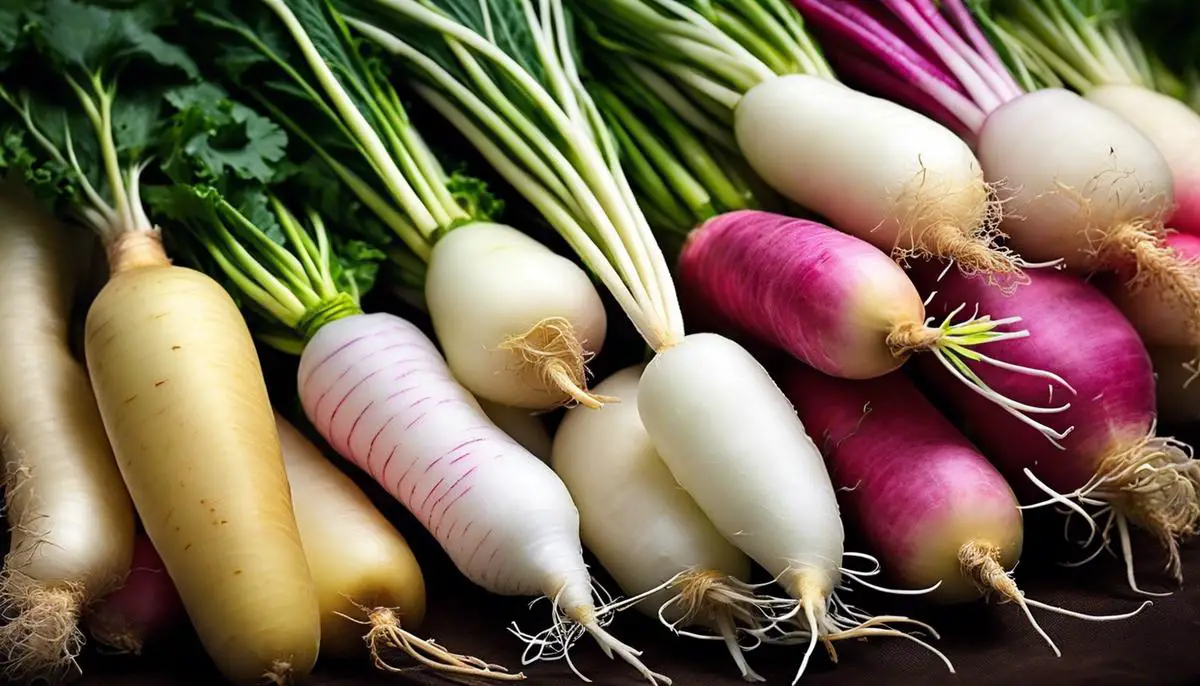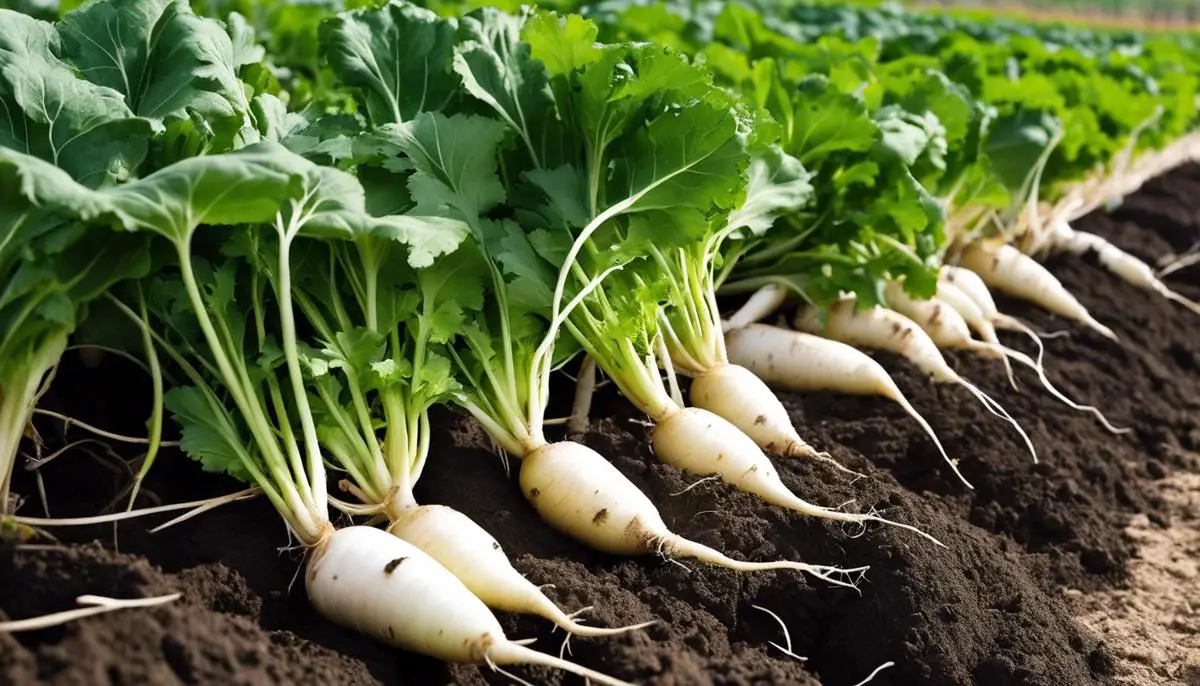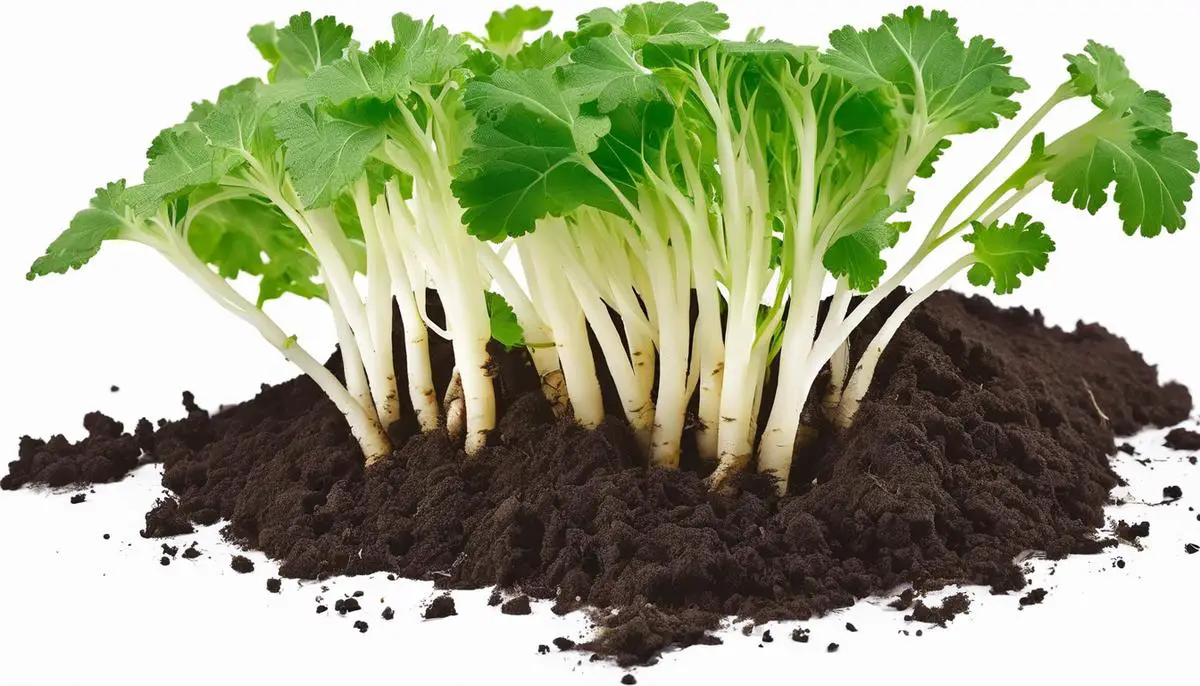Gardens are a canvas where the earth meets ambition, and amongst the many vibrant strokes of green we can create, the Daikon radish offers a particularly satisfying splash of culinary and gardening delight. Understanding the unique qualities of Daikon radishes begins with choosing the right variety; each one comes with its own set of characteristics, including size, taste, and climate preferences. As we delve into the world of these versatile root vegetables, we’ll explore the art and science of bringing them to life, from preparing the soil with the precision of a master gardener to nurturing the seedlings with the care of a watchful parent. Whether you’re a novice in the gardening world or a seasoned grower with a penchant for radishes, this journey through planting, caring, and harvesting Daikon radishes will equip you with the knowledge to reap a bounty as rewarding as it is delicious.
Understanding Daikon Radish Varieties
Discover the Diverse World of Daikon Radishes: Varieties for Every Gardener
When it comes to the bountiful world of root vegetables, the Daikon Radish reigns supremely versatile. Unlike its smaller, rounder cousins, Daikon radishes boast a long, white, tubular shape and a flavor that ranges from sweet and mild to pungent and peppery. Gardeners and food enthusiasts alike relish the chance to grow these crisp treats. Let’s dig into the various kinds you might plant in your own garden patch.
Reader Poll: What online courses would interest you?
To start, it’s worth noting that “Daikon” is a Japanese term literally meaning “big root,” but these hefty radishes are beloved in many culinary traditions from across Asia. Here are a few types that have become favorites among green-thumbed hobbyists.
1. Miyashige White Daikon
This Japanese heirloom is often a top choice for its sweet taste and tender texture. The Miyashige grows long and sturdy, with a classic Daikon look and an impressive ability to reach several pounds in weight when given enough room to thrive.
2. Minowase Daikon
Also hailing from Japan, the Minowase is another traditional variety that reaches up to 24 inches in length. It’s favored for its juicy crunch and ability to stand up well to both pickling and cooking. Those with smaller gardens take heart; it can also be harvested when young and small.
Subscribe to our newsletter!
3. Korean Mu
For those looking to spice up their culinary arsenal, Korean Mu is a must-try. This type offers a bit more bite than its Japanese counterparts and is a staple in Korean dishes such as kimchi. It typically grows a bit shorter and rounder, making it suitable for gardens with dense soil where longer varieties might struggle.
4. Altaglobe
A more recently developed variety, the Altaglobe has gained popularity for its globe-like shape and rapid maturation. It’s an excellent pick for gardeners with a shorter growing season and those who don’t want to wait too long to sample their radish harvest.
5. Shunkyo Semi-Long
The Shunkyo Semi-Long is a distinctive Chinese variety recognized by its rose-colored skin and elongated shape. It packs a warmer heat compared to other types and adds a colorful burst to any dish. This particular radish is as delightful to look at as it is to eat.
6. Watermelon Radish
Although not ‘Daikon’ by name, the Watermelon Radish is a Chinese radish very similar in use and cultivation. Its stunning pink-colored flesh, reminiscent of a watermelon, is hidden beneath a pale green and white skin. It’s both sweet and slightly peppery, perfect for adding visual pop and flavor to salads.
The brilliance of growing Daikons is in their adaptability. They flourish in cool weather, making them ideal for both spring and fall plantings. These radishes have deep roots (no pun intended) that help break up the soil, making them excellent for crop rotation and improving garden bed conditions for subsequent plants.
When considering the different varieties, always match them to your climate, soil type, and culinary preferences. Daikon radishes can be nifty storage crops too so that you can enjoy the fruits of your labor well into the winter months. No matter which type you opt to grow, they’re sure to add diversity and interest to your gardening pursuits and your palate. Growing Daikon radishes might just be the root of your gardening success!

Planting and Soil Preparation
When it comes to diving into the practical, dirt-on-your-hands part of growing Daikon radishes, the soil preparation and planting stages are critically important to ensure a successful, bumper crop. Here’s a run-through of how to best prepare the soil and plant those seeds to get the most out of your gardening efforts.
Firstly, we want to discuss soil preparation. Daikon radishes are pretty forgiving but they favor a loose, well-drained soil that’s rich in organic matter. Loamy soil is your best bet. The goal is to provide a welcoming environment for those long roots to penetrate deeply. Begin by working the soil at a depth of 12 to 18 inches to remove any rocks or debris that could impede growth or cause the radishes to become misshapen.
Next, get your hands on some well-rotted compost or aged manure to enrich the planting area. This addition ensures the soil is packed with nutrients. Daikons are heavy feeders, so don’t skimp on this step. Mix this organic matter in thoroughly with the existing soil.
As for pH levels, aim for a range between 5.8 and 6.8, which is slightly acidic to neutral. Use a pH test kit if needed and adjust accordingly with lime (to raise pH) or sulfur (to lower pH). Getting this right is crucial since the pH affects the availability of nutrients.
Now, let’s move on to planting. Timing is key with Daikon radishes. They’re cool-season crops, so plan to sow seeds directly into the garden either in early spring, three to four weeks before the last frost, or late summer for a fall harvest. These radishes don’t do well with transplanting – direct sowing is the way to go.
Plant seeds half an inch deep and about an inch apart. If you’re planting multiple rows, space the rows 12 to 18 inches apart to give these radishes room to grow. After sowing, water the area gently but thoroughly; the soil should be kept consistently moist, which encourages even germination.
When the seedlings are a couple of inches tall, it’s thinning time. This can be hard for the tender-hearted gardener, but trust that it’s for the greater good. Thin your seedlings so they’re about 4 to 6 inches apart to give each radish optimal room to mature.
The key to keeping Daikon radishes happy is consistent moisture, especially as they grow. A layer of mulch can be a real game-changer here. It’ll help to retain soil moisture and ward off weeds.
So there you have it, a blueprint for preparing the soil and planting Daikon radishes, aiming for the perfect harvest. It’s all about starting with a strong foundation – well-prepped soil – and planting with care according to the radish’s needs. Stick with these guidelines, and chances are you’ll be enjoying the fruits, or rather, the roots, of your labor before you know it!

Caring for Daikon Radish Plants
Caring for Daikon radish plants stretches beyond simply planting and watering. For enthusiasts diving into the cultivation of these satisfyingly crunchy roots, understanding the intricacies of their needs can make all the difference. Let’s deep-dive into an assortment of best practices to ensure your Daikon radishes thrive.
Firstly, let’s tackle fertilization. Daikon radishes aren’t particularly needy when it comes to feeding, but they do crave a balanced dose of nutrients. A balanced, slow-release fertilizer, applied at planting time, will support steady growth. Opt for a fertilizer with a good mix of nitrogen, potassium, and phosphorus—the trio that will keep your Daikons happy throughout their growing season.
Control pests and diseases proactively. Daikon radishes can fall prey to various pests and afflictions, such as flea beetles, root maggots, and clubroot. Implement row covers early on to keep insects at bay, and practice crop rotation to deter soil-borne diseases. If pests are spotted, organic options like neem oil or insecticidal soap can help handle them without harsh chemicals.
Ensure you’re savvy about the sunlight your radishes receive. Daikon radishes favor full sun, meaning at least six hours of direct sunlight per day. Yet, they’ll tolerate partial shade—just be aware that this might slow down their growth and yield slightly less robust radishes.
Now, about airflow and overcrowding: give your Daikon radishes space to breathe. Crowded conditions can spell trouble, limiting airflow around the plants, which could lead to disease and subpar radishes. It’s prudent to maintain good plant spacing and keep the garden free of debris and overgrown non-essentials.
Support your Daikon radishes with companions. Companionship isn’t a human-exclusive concept; plants enjoy good neighbors, too. Planting daikons with leafy greens or aromatic herbs can deter pests naturally and enhance growth, making for a well-rounded and mutually beneficial plant community.
Monitoring your radishes as they mature is a crucial part of the hobby. Gently loosen the soil around the top of the radish to check its size. Harvesting at the right time prevents overgrown, woody radishes. Generally, daikons are ready to harvest when they are about 1 to 2 inches in diameter, but this varies depending on the variety.
Last, be attentive and responsive. Keep a close watch on your plants for changes in leaf color or growth patterns and adjust your care routine to address any potential issues promptly. Regular checks and engagement with your Daikon radish plants not only lead to a successful harvest but also deepen your connection with the growing process.
Caring for Daikon radishes entails a wonderful confluence of patience, attentiveness, and the joys of working with one’s hands in the soil. With these best practices as a guide, gardeners can garner both robust radishes and an enriched gardening experience.

Harvesting and Storing Daikon Radishes
Harvesting and Preserving the Crisp, Refreshing Bounty of Daikon Radishes
Daikon radishes, with their long white roots and crisp texture, have come a long way from their traditional Asian origins to become a global favorite. But now, the real magic happens—harvest and storage. Acting at the right time with the right technique is key to enjoying these delicious vegetables at their best.
When to Harvest Daikon Radishes
Timing is crucial for harvesting daikon radishes to ensure they’re at peak flavor and texture. The best time to harvest is when they’ve grown to their expected size but are still tender, typically after 50 to 70 days from planting. If left in the ground too long, they may become woody and lose their signature mild flavor.
What to Look For:
- Diameter: Most varieties are best harvested when they’re about 2 to 4 inches in diameter.
- Length: Daikon varieties, such as Miyashige and Minowase, should be 12 to 18 inches long at the time of harvest.
- Feel: They should feel firm and solid, without any soft spots or excessive give.
How to Harvest Daikon Radishes
To harvest daikon radishes without harming the delicate root, follow these steps:
- Loosen the soil around the daikon with a gardening fork to prevent snapping the root.
- Grasp the green tops near the base and gently pull while you ease the radish out of the ground.
- Shake off any loose soil, and if necessary, brush off remaining dirt with your hands or a soft cloth.
After harvesting, radishes can be cleaned further by trimming the tops off, leaving about an inch of green stems, and washing them under cool running water to remove any remaining soil.
Storing Daikon Radishes
Proper storage can extend the life of your daikon radishes, maintaining their freshness for your culinary use.
Short-Term Storage:
- Refrigerate unwashed daikon radishes by wrapping them in a paper towel and placing them in a plastic bag. Stored this way, they can last for about two weeks.
- Ensure that the radishes are dry before refrigeration to prevent mold growth.
Long-Term Storage:
- For long-term storage options, consider pickling, fermenting, or drying.
- Pickled daikon, also known as ‘takuan’, is a popular method where radishes are salted and then pickled in a mixture of rice bran, sugar, and vinegar, which can last several months.
- Fermented daikon radish, common in Kimchi, can also significantly extend shelf life and add a zesty flavor.
- Dried daikon radish, in the form of strips or chips, can be rehydrated for later use, taking up minimal storage space.
In essence, enjoy the crispness of homegrown daikon radishes by harvesting them when they’re just right and using simple storage techniques to keep them fresh and flavorful. With a little love and care, the daikon radish can be a versatile and delightful addition to your garden and your table, ready for your favorite recipes or a crunchy, healthy snack straight from the earth.

As the final radishes are plucked from the earth, their crisp texture and peppery flavor a testament to the careful attention they’ve received, we step back to appreciate the cycle of growth and renewal that gardening embodies. Daikon radishes, with their diverse varieties and robust growth, have taken us from the anticipation of planting to the satisfaction of harvest. From selecting the perfect variety to match our culinary dreams to the patient nurturing of our crops against nature’s challenges, cultivating these radishes brings both sustenance and pleasure to our tables. May the crisp bite of freshly harvested Daikon remind us of the simple joy found in tending to the earth and the complex flavors it gifts in return, inspiring us to continue the journey of growth in seasons to come.

